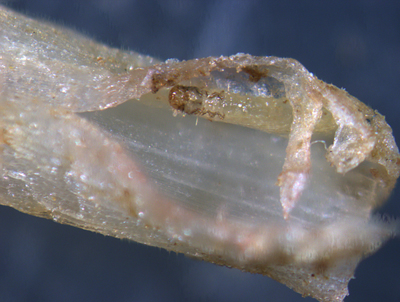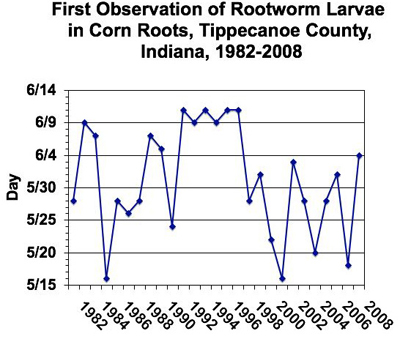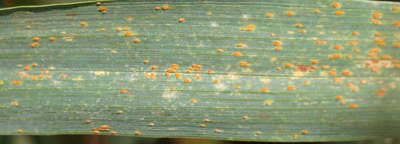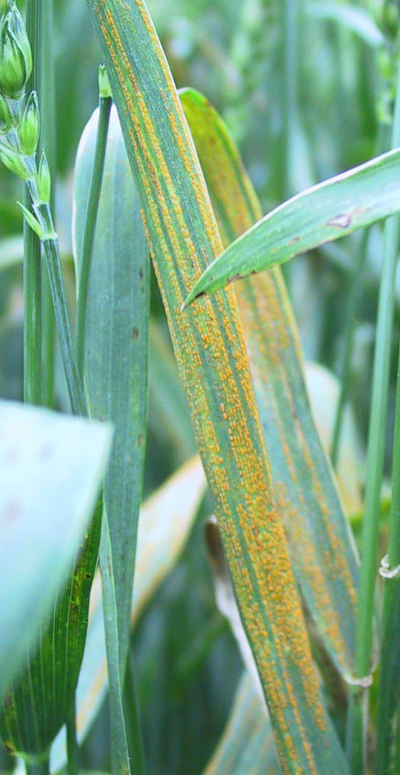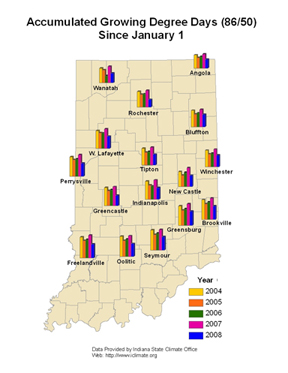Pest & Crop Newsletter, Entomology Extension, Purdue University
- Corn Rootworm Larvae and Stormy Weather Appear in West Central Indiana
- Mishmash of Insect Reports
- Black Light Trap Catch Report
- Effects of Flooding or Ponding on Young Corn
- Grain Sorghum Considerations for Late Planting in Southern Indiana
Corn Rootworm Larvae and Stormy Weather Appear in West Central Indiana – (Larry Bledsoe and John Obermeyer)
- Western corn rootworm larvae is found June 4 in WC Indiana.
- Small larvae are vulnerable to drowning.
- Assessing insecticide performance will be possible in a couple weeks.
- Look for late June/early July appearance of adults.
Not unexpectedly, considering May weather, western corn rootworm (WCR) larvae have appeared in roots of V3 corn near Lafayette, Tippecanoe County about two weeks later than last year. The average date that larvae have been first detected in roots during the last 27 years is May 31, so the appearance of larvae this year on June 4 is not too far off the mark for WCR emergence. The range of date of detection at Lafayette has been May 16 to June 11. The detection date is a few days later than when eggs actually begin to hatch because it takes a few days for the number of larvae to reach a level that we can find them by searching 50 to 100 plants per day. The majority of eggs in central Indiana will hatch during the next 15-20 days. Producers in southern counties should adjust emergence estimates by subtracting a few days and northern counties should add a few days to estimate CRW emergence in your area. WCR scouting and soil insecticide performance evaluations should begin about a week after larval emergence commences.
Corn rootworm larva in root
Recent extensive rain has prompted questions about the impact of saturated soil on larval survival. WCR adults have a tendency to lay eggs during late summer where soil is a little more moist and cooler than surrounding soil. These areas are typically found in soil types and field depressions that tend to collect and hold moisture in late summer. This is why the distribution of WCR injury in the following year tends to be clumped. These same areas that are attractive to WCR adults for egg laying are where soils tend to become saturated first and remain wet longest when rain is extensive. Therefore, the impact of drenching rains on rootworm can be significant if the timing is correct. Rootworm eggs are very resistant to flooding and fields would have to be submerged many days before adverse impact would occur. First instars, newly hatch larvae, are particularly susceptible to saturated soil and will die after being denied air for a less than a day. Second instars that are still embedded in roots will generally not survive in submersed or heavily saturated soil after a day or two. The warmer the soil, the more rapidly stressed larvae die. Larvae that are free to quickly move close to the soil surface have greater survival potential. Third instars will be least affected and tend to concentrate at the surface of saturated soil and feed extensively on the root nodes at, or just below, the surface. Excessive or merely high soil moisture are sometimes responsible for concentrating injury on developing brace roots and/or on the node immediately below the surface and can result in unexpected plant lodging in fields thought to be at low risk from injury.
Egg hatch is already well underway in southern counties and this is where excessive soil moisture will have the greatest overall impact on larval survival. Egg hatch has just begun in central Indiana and current heavy rainfall will have minimal impact because the majority of larvae have yet to hatch. Flooding impacts on WCR survival in northern counties would not be a consideration until mid to late June. Anyone in central or northern counties still planting corn during the next two weeks should consider using a soil insecticide on conventional hybrids to protect the roots of emerging plants. If replanting, be careful that you do not exceed insecticide label rates.
![]()
Mishmash of Insect Reports – (John Obermeyer)
Brad Shelton, Washington County CES, has visited some corn fields, no-tilled into wheat, that were eaten to the nubbins by armyworm larvae “marching” across and into the neighbors. Infestations were spotty throughout the county. Larry Wickert, Wickert Agronomy Services, has observed some Asiatic garden beetle larvae damage in Starke County cornfields. Infestations are isolated in certain fields. Brian Early, BTS Consulting, has found some fields in north central counties with black cutworm infestations that were at threshold. Those fields had considerable spring weedy growth.
![]()
Click here to view the Black Light Trap Catch Report
Methods to Control Volunteer Roundup Ready or Glyphosate - Tolerant Corn in a Corn Replant Situation – (Bill Johnson and Glenn Nice)
Due to the recent cold wet weather, corn planted in early May has struggled to emerge and there are a number of fields which will be replanted. There are four legal options to kill an existing stand of Roundup Ready or GT corn in a replant situation – tillage, Select Max, Gramoxone, or Liberty. Our experience has been that tillage will be the most reliable method, and would not have the waiting interval associated with Select Max, but is not desirable for those in a long-term no-till situation.
Select Max has received a label for control of volunteer corn in a corn replant situation. The use of Select Max will provide better control of volunteer corn than Gramoxone or Liberty, but you cannot plant until 6 days after the field is treated with Select Max. The directions on the label indicate that up to 6 fl oz/A can be applied and NIS at 0.25% and AMS at 2.5 to 4 lb/A should be used as the spray additives. Apply to corn that is 12 inches or less. Avoid overlapping the boom for overlaps may result in rates that can cause excessive crop injury.
Gramoxone or Liberty may not always be 100% effective, but the labels for these products do allow this type of use. In University research trials, Gramoxone (2-3 pt/A) + Sencor (4-6 oz/A) or 32 to 34 oz/A of Liberty has been effective for control of small corn (V1 to V3). Application of Gramoxone alone, without the addition of Sencor, is likely to be less effective. Corn that has advanced past the V3 growth stage will generally be more difficult to control. A combination of Gramoxone plus Sencor is likely to be more effective than Liberty on this size corn, unless Liberty Link corn is planted and a follow up treatment of Liberty can be used after emergence of the new stand to control plants that survived the first application.
Information listed here is based on research and outreach extension programming at Purdue University and elsewhere. The use of trade names is for clarity to readers of this site, does not imply endorsement of a particular brand nor does exclusion imply non-approval. Always consult the herbicide label for the most current and update precautions and restrictions. Copies, reproductions, or transcriptions of this document or its information must bear the statement ‘Produced and prepared by Purdue University Extension Weed Science’ unless approval is given by the author.
Rusts of Wheat - (Gregory Shaner)
- Any of three rusts may show up in Indiana.
Three different rust fungi infect wheat. The rust disease most commonly seen in Indiana is leaf rust. Stem rust is rare. Stripe rust is sometimes found in isolated patches as wheat reaches the head emergence stage, but fades away with the arrival of hot weather.
These rust fungi overwinter only on living host plants in the southern US and Mexico. Southerly winds carry spores north in the spring, where they infect wheat when there is sufficient duration of dew on leaves at night.
Stem rust was recently reported in Keiser, Arkansas, which lies 225 miles southwest of Evansville. It has also been found in many areas farther south, from the Carolinas to Texas. With rust so near, it is possible that it will show up in Indiana. Stem rust requires warm weather to develop. Usually wheat in Indiana matures before temperatures are high enough for stem rust to thrive. However, development of wheat in Indiana is behind normal this year, because of the cool spring. Now that hot weather has arrived, there may be time for stem rust to infect and develop on susceptible cultivars before they mature. Fortunately most winter wheat cultivars are resistant to the race that has been identified in the South. I suspect that most cultivars in Indiana will be resistant to stem rust, but some may be susceptible.
Of the three rusts on wheat, stripe rust prefers the coolest weather. We often see it in patches (foci) in fields about the time wheat heads. Rust may be quite severe on all plants in an area of only a few feet in diameter, but almost absent in most of the field. As temperatures rise, stripe rust ceases to spread and existing pustules dry up. There is some stripe rust to the south of Indiana, but not much.
Leaf rust is favored by moderate temperatures, so is the rust most commonly seen in Indiana. Leaf rust has been found throughout the South. While I was examining a wheat leaf from Tippecanoe County for Stagonospora leaf blotch under the microscope, I saw a single rust spore, but no pustules. A caller yesterday reported finding one pustule on a wheat leaf. It is possible that leaf rust will develop over the next couple of weeks. Many cultivars grown in Indiana are resistant to leaf rust.
The three rusts are reasonably easy to distinguish. Each rust is shown in the images below. As its name implies, stem rust produces pustules on stems, but will also produce pustules on leaf sheaths and leaf blades. The pustules are large, brick red, and are surrounded by jagged host epidermis, torn as the pustule erupts. Leaf rust pustules are smaller, orange, and elliptical. These also rupture through the epidermis, but don’t result in the jagged flaps seen with stem rust. Leaf rust pustules rarely develop on leaf sheaths and never on stems. Stripe rust pustules are yellow and occur in long stripes on leaf blades.
Stem rust
Leaf rust
Stripe rust
Effects of Flooding or Ponding on Young Corn - (Bob Nielsen)
Recent intense rainfall events (technically referred to as “toad stranglers” or “goose drownders”) have caused flooding of low-lying corn fields or ponding in poorly drained swales within fields. Other areas within fields, while not technically flooded or ponded, may remain saturated for lengthy periods of time. What are the prospects for recently submerged corn fields?
The sarcastic answer is that flooded crops will survive until they die. What this statement means is that no one can tell you with certainty the day after the storm whether a ponded area of a corn field will survive or whether there will be long-term yield consequences until enough time has gone by such that you can assess the actual recovery of the damaged plants. We can, however, talk about the factors that increase or decrease the risks of severe damage or death to flooded soils.
• Corn that is completely submerged is at higher risk than corn that is partially submerged.
* Plants that are only partially submerged may continue to photosynthesize, albeit at limited rates.
• The longer an area remains ponded, the higher the risk of plant death.
* Most agronomists believe that young corn can survive up to about 4 days of outright ponding if temperatures are relatively cool (mid-60’s°F or cooler); fewer days if temperatures are warm (mid-70’s°F or warmer).
* Soil oxygen is depleted within about 48 hours of soil saturation. Without oxygen, the plants cannot perform critical life sustaining functions; e.g. nutrient and water uptake is impaired and root growth is inhibited.
• Even if surface water subsides quickly, the likelihood of dense surface crusts forming as the soil dries increases the risk of emergence failure for recently planted crops.
* Be prepared with a rotary hoe to break up the crust and aid emergence.
• The greater the deposition of mud on plants as the water subsides, the greater the stress on the plants due to reduced photosynthesis.
* Ironically, such situations would benefit from another rainfall event to wash the mud deposits from the leaves.
• Corn younger than about V6 (six fully exposed leaf collars) is more susceptible to ponding damage than is corn older than V6.
* This is partly because young plants are more easily submerged than older taller plants and partly because the corn plant’s growing point remains below ground until about V6. The health of the growing point can be assessed initially by splitting stalks and visually examining the lower portion of the stem (Nielsen, 2008b). Within 3 to 5 days after water drains from the ponded area, look for the appearance of fresh leaves from the whorls of the plants.
• Extended periods of saturated soils AFTER the surface water subsides will take their toll on the overall vigor of the crop.
* Some root death will occur and new root growth will be stunted until the soil dries to acceptable moisture contents. As a result, plants may be subject to greater injury during a subsequently dry summer due to their restricted root systems.
• Concomitant (I found a new word in the dictionary!) with the direct stress of saturated soils on a corn crop, flooding and ponding can cause significant losses of soil nitrogen due to denitrification and leaching of nitrate N.
* Significant loss of soil N will cause nitrogen deficiencies and possible additional yield loss.
* On the other hand, if the corn dies in the ponded areas it probably does not matter how much nitrogen you’ve lost.
• Lengthy periods of wet soil conditions favor the development of seedling blight diseases, especially those caused by Pythium fungi (Sweets, 2008).
* Poorly drained areas of fields are most at risk for the development of these diseases and so will also be risky for potential replant operations.
• Certain diseases, such as common smut and crazy top, may also become greater risks due to flooding and cool temperatures (Malvick, 2002).
* The fungus that causes crazy top depends on saturated soil conditions to infect corn seedlings.
* The common smut fungal organism is ubiquitous in soils and can infect young corn plants through tissue damaged by floodwaters. There is limited hybrid resistance to either of these two diseases and predicting damage is difficult until later in the growing season.
Related References
Elmore, Roger and Lori Abendroth. 2008. Flooded Corn and Saturated Soils. Integrated Crop Management Newsletter, Iowa State Univ Extension. [On-line]. Available at <http://www.extension.iastate.edu/CropNews/2008/Issues/20080602.htm>. [URL accessed 6/2/08].
Farnham, Dale. 1999. Corn survival in wet conditions. Iowa State Univ. Integrated Crop Management Newsletter. [On-line] Available at <http://www.ent.iastate.edu/ipm/icm/1999/5-24-1999/wetcorn.html>. [URL accessed 6/2/08].
Malvick, Dean. 2002. Crazy Top in Corn. The Bulletin, Univ of Illinois Extension. [On-line]. Available at <http://www.ipm.uiuc.edu/bulletin/pastpest/articles/200220c.html>. [URL accessed 6/3/08].
Nielsen, RL (Bob). 2008a. Determining Corn Leaf Stages. Corny News Network, Purdue Univ. [On-Line]. Available at <http://www.kingcorn.org/news/timeless/VStageMethods.html>. [URL accessed 6/1/08].
Nielsen, RL (Bob). 2008b. Growing Points of Interest. Corny News Network, Purdue Univ. [On-Line]. Available at <http://www.kingcorn.org/news/timeless/GrowingPoints.html>. [URL accessed 6/1/08].
Nielsen, RL (Bob). 2008c. Tips for Staging Corn with Severe Leaf Damage. Corny News Network, Purdue Univ. [On-Line]. Available at <http://www.kingcorn.org/news/timeless/VStagingTips.html>. [URL accessed 6/1/08].
Nielsen, RL (Bob). 2008d. Use Thermal Time to Predict Leaf Stage Development in Corn. Corny News Network, Purdue Univ. [On-Line]. Available at <http://www.kingcorn.org/news/timeless/VStagePrediction.html>. [URL accessed 6/1/08].
Owen, Mike. 2008a. Replant Options in Corn Fields. Integrated Crop Management Newsletter, Iowa State Univ Extension. [On-line]. Available at <http://www.extension.iastate.edu/CropNews/2008/Issues/20080602.htm>. [URL accessed 6/2/08].
Owen, Mike. 2008b. Replanting Corn – How Do You Get Rid of the Existing Stand? Integrated Crop Management Newsletter, Iowa State Univ Extension. [On-line]. Available at <http://www.extension.iastate.edu/CropNews/2008/Issues/20080602.htm>. [URL accessed 6/2/08].
Sweets, Laura. 2008. Seed Decay and Seedling Blights of Corn. Integrated Pest & Crop Management Newsletter, Univ of Missouri Extension. [On-line]. Available at <http://ppp.missouri.edu/newsletters/ipcm/archives/v18n9/v18n9.pdf>. [URL accessed 6/3/08].
Thomison, Peter. 2006. Ponding Effects on Corn. C.O.R.N. Newsletter, Ohio State Extension. [On-line]. Available at <http://corn.osu.edu/index.php?setissueID=134>. [URL accessed 6/2/08].
![]()
Grain Sorghum Considerations for Late Planting in Southern Indiana - (Bob Nielsen, Bill Johnson, and Glenn Nice)
- Sorghum can be a viable alternative to late-planted corn in southern Indiana, but only through early July.
- Some risks are involved in growing sorghum.
- Sorghum management tips are provided.
Grain sorghum, sometimes called “milo”, can be a viable late-planting option for southern Indiana farmers faced with late planting dilemmas, especially where fields have already been treated with certain corn herbicides. What are the opportunities and risks involved with switching from corn to sorghum? What cultural practices are followed in producing sorghum?
Opportunities
Grain sorghum is an acceptable crop alternative to corn for hog and cattle producers who otherwise may have to purchase corn this fall. The feed value of grain sorghum approaches or equals that of corn, especially that of yellow endosperm sorghum hybrids.
Grain sorghum is well suited to those soils or conditions often considered marginal for corn. Sorghum can be planted later than corn and still yield reasonably well. Sorghum performs more consistently than corn on light, well-drained, often droughty soils as well as on soils that are prone to flooding or lengthy periods of soil saturation. Sorghum is also more tolerant to mid-summer drought conditions than is corn.
Risks
Potential sorghum growers need to be aware that learning the ins and outs of producing a crop they’ve never grown before can be daunting in normal growing seasons, let alone in an unusually delayed planting season that some are experiencing this year. Because of this, growers faced with feed grain shortages this fall and winter may want to consider planting to soybean instead and using the grain sale revenue to purchase their feed grain later.
Grain sorghum grown for the cash grain market can be risky due to limited market availability. In southern Indiana, marketing opportunities are primarily along the Ohio River. Growers should attempt to “nail down” a contract to sell their intended grain before venturing into sorghum production.
Herbicide selection for use in grain sorghum is generally more limited than for corn. If Lasso or Dual herbicides are already applied to your fields, then seed sorghum with a commercially applied seed safener should be planted. Otherwise, serious herbicide injury could occur.
Ripening heads of grain sorghum can be very attractive to a number of bird species. Consequently, production of grain sorghum near areas with large populations of birds (typically, urban areas) invites bird feeding on the exposed heads and significant grain damage and yield loss.
Be aware that availability of sorghum seed may be limited simply because sorghum is not a widely-grown crop in Indiana and seed dealers will likely need to transport seed sorghum in from other areas of the U.S.
Field dry-down of sorghum grain can be slow and unpredictable. Several weeks of rain or high humidity in the fall can result in sprouted, moldy, low-quality grain as well as excessive losses due to stalk lodging, grain shattering, and bird feeding.
If mechanical drying is necessary for storage of sorghum, be prepared for frustration. Air movement through sorghum will be 25 to 40% slower than through corn because the sorghum’s smaller kernels pack closer together and sorghum tends to have more foreign matter in it.
General Cultural Practices
Hybrid Selection. Hybrids suitable for planting from late May through early July must be early enough in maturity to complete dry matter accumulation prior to a killing fall frost. As with corn, there is no industry-wide standard for describing hybrid maturity in grain sorghum. The accompanying table lists relative hybrid maturities for several areas of southern Indiana for several planting periods. Consult your seed dealer for specific recommendations for your area and planting conditions.
| Table 1. Recommended relative hybrid maturity for grain sorghum planted from late May through early July for several areas of southern Indiana. | ||
| Location | Planting Period | Relative Hybrid |
| Southwest Indiana, south of Hwy 50 | Late May - mid June Late June - early July After early July |
Full Medium Too risky to plant |
| Southwest Indiana, Hwy 50 to Hwy 40 | Late May - mid June Late June - early July After early July |
Medium Early Too risky to plant |
| Southeast Indiana | Late May - mid June Late June - early July After early July |
Medium Early Too risky to plant |
In addition to maturity factors, select hybrids with yellow endosperm characteristics because of their superior feeding value. Select hybrids with good stress tolerance. Depending on your herbicide program (see the following herbicide sections), you may need to select hybrids treated with chemical seed safeners.
Planting Depth. Grain sorghum seed is very small compared to either corn or soybeans, averaging about 16,000 seeds per pound. Therefore, good seed to soil contact is important for uniform and rapid germination. Planting depth should only be about one inch in most soils, up to 2 inches in sands.
Row Spacing. Grain sorghum grown this late in the season should be planted in narrow rows if possible. Narrow rows encourage rapid canopy closure and the subsequent shading will help reduce soil moisture evaporation and improve weed control. Use a grain drill with effective furrow closure wheels, or planters with 15- to 20-inch row units. Either would be preferable to 30-inch or greater row spacing.
Seeding Rates. Necessary equipment for row crop planters would include 60 cell milo plates (plate planters), sorghum cups (Deere), special drums (Case-IH Cyclo), or sorghum seed disks (air and vacuum planters). Harvest populations should be approximately 60,000 to 100,000 plants per acre for lower and higher productivity soils, respectively.
To achieve such harvest populations, figure on seeding rates of about 86,000 to 143,000 seeds per acre (assuming 70% field emergence). Be sure to check the seed size and adjust planted pounds per acre accordingly. At 12,000 seeds per pound, these seeding rates equal 7.2 to 11.9 pounds per acre. At 16,000 seeds per pound, these seeding rates equal 5.5 to 9.0 pounds per acre. Time spent on calibrating your planter or drill to achieve accurate seed drop is time well spent.
Corn Herbicides Already Applied to Fields. Where corn herbicides have already been applied to fields, growers should be cautious when grain sorghum will be planted instead because of the risk for crop injury.
• Sorghum may be planted immediately where Dual/Dual II Magnum, all Bicep II Magnum products, Lasso/Microtech/Intrro, Bullet/Lariat, atrazine, Outlook, all Guardsman products, Banvel, Clarity or Marksman have been applied.
* Commercially applied seed safeners are usually required when either metolachlor (Dual) or alachlor (Lasso) have been or will be applied. The safener “Screen” is required where Lasso/Microtech/Partner/Lariat have been applied, while “Screen” or “Concep” are recommended where Dual or Bicep products have been applied. Since it’s rather difficult to determine how much herbicide residue remains in fields treated this spring, a seed safener is an inexpensive insurance premium to ensure seedling emergence.
• Sorghum may be planted 1 month after the corn herbicide Define has been applied.
• Commonly used corn herbicides with a 2 month or longer rotational interval to grain sorghum include: All acetochlor products, Accent products, Balance Pro, Basis products, Beacon products, Callisto/Lumax/Lexar, Celebrity Plus, Distinct, Epic, Exceed/Spirit, FieldMaster, Hornet, Lightning, Northstar, Princep, Python, Steadfast.
Postemergence Herbicides Registered For Use With Grain Sorghum. Consult the Purdue/Ohio State “Weed Control Guide for Ohio and Indiana” <http://www.btny.purdue.edu/Pubs/WS/WS-16/GrainSorgHerbRating.pdf> or your local herbicide supplier for specific details on weeds controlled.
• Gramoxone Inteon (paraquat) or Roundup (glyphosate) can be used to control existing vegetation before planting grain sorghum in reduced-tillage systems.
• 2,4-D may be applied for broadleaf control in sorghum that is 6 to 15 inches tall. Use drop tubes if sorghum is taller than 8 inches. Use amine formulations at 1 pt/A and ester formulations at 0.5 pt/A. Shotgun (2,4-D + atrazine) can be used on sorghum at 2 pt/A as a broadcast spray from spike to 8 inches tall and with drop tubes on 8 to 12 inch tall sorghum.
• Aim (carfentrazone) may be used postemergence at 0.5 oz/A for control of velvetleaf, morningglories, nightshade and pigweeds/waterhemp less than 4 inches tall. The label does not provide specific information on sorghum growth stage limitations.
• Atrazine may be applied to medium-textured soils with more than 1 percent organic matter, but the rates are lower than for corn. Atrazine can also be applied postemergence at 4 to 6 pints 4L per acre without crop-oil concentrate (COC) or at 2.4 pints per acre with COC for broadleaf control only. Use equivalent rates of atrazine 90DF. Apply after grain sorghum reaches the 3-leaf stage, but before it reaches 12 inches in height. Atrazine is a restricted-use pesticide.
• Banvel (dicamba) or Marksman (dicamba + atrazine) can be applied to grain sorghum after the 2-leaf stage. Marksman can be applied at 1-1/2 to 2 pints per acre until sorghum has five leaves or is 8 inches tall; Banvel can be applied at 0.5 pint per acre to sorghum up to 15 inches tall. Do not graze or feed treated forage to animals before the mature grain stage. Marksman is a restricted-use pesticide.
• Basagran (bentazon) may be used at 1.5 to 2 pints per acre on sorghum or forage sorghum that is between the first and fifth leaf stage. Laddok (bentazon + atrazine) can be used postemergence to control broadleaf weeds in grain sorghum if applied before the crop is 12 inches tall. Laddok is a restricted-use pesticide.
• Buctril (bromoxynil) applied alone can be used from the 3-leaf to boot stage, while Buctril that has been tank-mixed or premixed with atrazine can only be applied to grain sorghum up to 12 inches in height. Buctril+Atrazine is a restricted-use pesticide.
• Peak (prosulfuron) is a postemergence broadleaf herbicide used at 0.5 to 1/oz/A that can be applied to grain sorghum that is between 5 and 30 inches tall. However, Peak herbicide is persistent in the soil and the recropping interval is a minimum of 10 months for soybean, with a longer rotational interval on high pH soils.
• Permit (halosulfuron) is a postemergence broadleaf herbicide that can be applied at 0.67 to 1.33 oz/A to grain sorghum up to 30 inches tall. Permit requires a 9-month rotational interval for soybean.
• Prowl + atrazine may be used as an early postemergence treatment in sorghum at a Prowl 3.3E rate of 1.8 to 2.4 pints per acre. Apply after the 3-leaf stage of grain sorghum, but before it is 12 inches tall.
• Yukon (dicamba + halosulfuron) can be used at 4 to 6 oz/A as a postemergence treatment. Apply after grain sorghum has 2 leaves but before it is 8 inches tall. Drop tubes can be used on sorghum 8 to 15 inches tall.
Fertility Needs. Sorghum’s nitrogen needs are similar to those of corn. For sorghum following soybean, figure 1 lb. of actual nitrogen per bushel of expected yield. For sorghum following corn or wheat, figure 1.2 lb. of actual nitrogen per bushel of expected yield. Since expected grain yields of sorghum planted from mid-June to early July in southern Indiana range from 70 to 110 bushels per acre, the crop’s total nitrogen needs will be 70 to 110 lbs N for sorghum following soybean and 84 to 132 lbs N for sorghum following corn. If nitrogen has already been applied to a field that was subsequently subjected to extensive rainfall and flooding, some loss will have occurred due to denitrification or leaching. Nitrogen losses from fertilizer applications prior to April 1 may be greater than 50%.
Roguing. Be prepared for off-type sorghum plants that may occur in a field of grain sorghum. These are natural in many sorghum hybrids. Most are genetic mutants with similar grain heads, but taller than normal. Others with off-type grain heads should be removed (rogued) from the field to reduce the risk of volunteer sorghum “weeds” coming back next year.
Harvesting. As with corn, grain sorghum is physiologically mature (maximum grain dry weight) at about 30 % grain moisture. Minimal harvest loss and seed damage occurs when harvested at grain moistures of about 20 percent. Achieving this grain moisture by field dry-down under Indiana rainfall and humidity conditions may be risky. Be prepared for frustration!
For More Information
At the risk of offending or neglecting some seed companies, brand names to consider for seed sorghum in Indiana include Dekalb, Asgrow, NC+, Pioneer, Garst, Golden Harvest, Mycogen, and Triumph. Talk to your local seed representative or company agronomist for more information about the risks, opportunities, hybrid maturity selection criteria, and other concerns regarding grain sorghum production for delayed planting in southern Indiana.
Related References
Sorghum Management Information. 2008. Purdue Univ. Agronomy Extension. [On-line]. Available at <http://www.agry.purdue.edu/ext/sorghum/index.html>. [URL accessed 6/4/08].
Loux, Mark M., Anthony F. Dobbels, Jeff M. Stachler, William G. Johnson, Glenn R.W. Nice, and Thomas T. Bauman. 2008. Weed Control Guide for Ohio and Indiana. Purdue Univ. and Ohio State Univ. [On-line]. Available at <http://www.btny.purdue.edu/Pubs/WS/WS-16/GrainSorgHerbRating.pdf>. [URL accessed 6/4/08].
Sorghum Seed Suppliers: [URLs accessed 6/3/08]
•Garst. <http://www.garstseed.com/GarstClient/Products/Sorghum>.
•Golden Harvest. <http://www.goldenharvestseeds.com/Profile_Chooser_Sorghum.asp>.
•Monsanto (Dekalb, Asgrow). <http://www.asgrowanddekalb.com/web/products/sorghum/index.jsp>.
•Dow AgroSciences/Mycogen. <http://www.dowagro.com/mycogen/sorghum>.
•NC+ Hybrids. <http://www.nc-plus.com/products/detail.cfm?crop=g>.
•Pioneer Hi-Bred Int’l. <http://www.pioneer.com>.
•Triumph Seed Company. <http://www.triumphseed.com/Products/sorg1.html>.
For other timely crop management information go to the Chat ‘n Chew Cafe: <http://www.kingcorn.org/café>. CNN Archives:<http://www.kingcorn.org/news/archive.html>.

